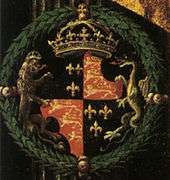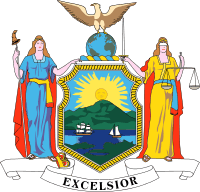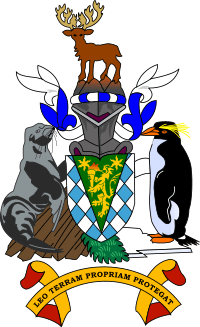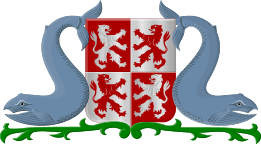Supporter
| Part of a series on |
| Heraldic achievement |
|---|
| Conventional elements of coats of arms |
|
|



In heraldry, supporters, sometimes referred to as attendants, are figures usually placed on either side of the shield and depicted holding it up. Unlike the coronet or helmet and crest, supporters were not part of medieval heraldry. Early forms of supporters are found in medieval seals; as part of the heraldic achievement, they first become fashionable towards the end of the 15th century, and even in the 17th century were not necessarily part of the full heraldic achievement (being absent, for example, in Siebmachers Wappenbuch of 1605).
The figures used as supporters may be based on real or imaginary animals, human figures, and in rare cases plants or inanimate objects. Often, these can have local significance, such as the fisherman and the tin miner granted to Cornwall County Council, or a historical link; such as the lion of England and unicorn of Scotland in the two variations of the Coat of Arms of the United Kingdom. The arms of nutritionist John Boyd-Orr use two 'garbs' (wheat sheaves) as supporters; the arms of the USS Donald Cook, missiles; the arms of the state of Rio Grande do Norte in Brazil, trees.[1] Letters of the alphabet are used as supporters in the arms of Valencia, Spain.
Human supporters can also be allegorical figures, or, more rarely, specifically named individuals.[2]
There is usually one supporter on each side of the shield, though there are some examples of single supporters placed behind the shield, and the arms of the Congo provide an extremely unusual example of supporters issuing from behind the shield.[3] While such single supporters are generally eagles[4] with one or two heads, there are other examples, including the cathedra in the case of some Canadian cathedrals.[5] At the other extreme and even rarer, the Scottish chief Dundas of that Ilk had three supporters: two conventional red lions and the whole supported by a salamander. The coat of arms of Iceland even has four supporters.[6]
Attitude
Animal supporters are, by default, as close to rampant as possible, if the nature of the supporter allows it (this does not need to be mentioned in the blazon), though there are some blazoned exceptions. An example of whales 'non-rampant' is the arms of the Dutch municipality of Zaanstad.[7]
Entitlement
Canada
In Canada, Companions of the Order of Canada, Commanders of the Order of Military Merit, Commanders of the Royal Victorian Order: people granted the style 'the Right Honourable', and corporations are granted the use of supporters on their coats of arms.[8][9] Further, on his retirement from office as Chief Herald, Robert Watt was granted supporters as an honour.[10]
New Zealand
Knights Grand Companion and Principal Companions of the New Zealand Order of Merit are granted the use of heraldic supporters.[11]
United Kingdom
In the United Kingdom, supporters are typically an example of special royal favour, granted at the behest of the sovereign.[12] Hereditary supporters are normally limited to hereditary peers, certain members of the Royal Family, and to some chiefs of Scottish clans. Non-hereditary supporters are granted to life peers, Knights and Ladies of the Order of the Garter and Order of the Thistle, Knights and Dames Grand Cross of the Order of the Bath, Order of St Michael and St George, Royal Victorian Order and Order of the British Empire, and Bailiffs and Dames Grand Cross of the Order of St John. Knights banneret were also granted non-hereditary supporters, but no such knight has been created since the time of Charles I. Tom Brown was so knighted by George II at the Battle of Dettingen,[13] the last battle at which a British sovereign was personally present.
Supporters may also be granted to corporations which have a Royal charter.
Examples
-

Two trees in the coat of arms of Rio Grande do Norte.
-
.svg.png)
The two L's in the coat of arms of Valencia (city) mark it as 'doubly loyal'.
-
An angel is the single supporter of this Kraków sculpture of the arms of Poland.
-
Flags and cannons are the supporters in the arms of Kazimierz Raczyński
-
.svg.png)
The coat of arms of Spain is supported by columns representing the Pillars of Hercules.
-

The coat of arms of Austria has one supporter, an eagle, which bears the escutcheon on its breast. This arrangement is common where eagles and other birds are used as supporters, as in the Great Seal of the United States and the coat of arms of Russia.
-

The allegorical figures Liberty and blindfolded Justice support a shield on the flag of the State of New York
-
.jpeg)
The coat of arms of the Municipality of New Belgrade is supported by two swallows.
-

Badgers on the arms of County Fermanagh, Northern Ireland.
-

The arms of South Georgia and the South Sandwich Islands feature a fur seal and macaroni penguin as supporters.
-

Royal arms of the United Kingdom (as used in England, Northern Ireland and Wales) has lion supporter (for England) in the dexter and unicorn supporter (for Scotland) in the sinister.
-
.svg.png)
Royal arms of the United Kingdom (as used in Scotland) gives Scottish elements pride of place, including switching the unicorn supporter to the dexter.
-

Coat of Arms of Malaysia which has two tigers as the supporters.
See also
References
| Wikimedia Commons has media related to Heraldic supporters. |
| Look up supporter in Wiktionary, the free dictionary. |
- ↑ http://www.ngw.nl/heraldrywiki/index.php?title=Rio_Grande_do_Norte
- ↑ Flags of the World — Blumenau, Santa Catarina(Brazil)
- ↑ CONGO
- ↑ e.g. Perth & Kinross District Council (Scotland) at Heraldry of the World
- ↑ Arms and supporter granted to Saint Paul's Cathedral, Regina, Saskatchewan
- ↑ Iceland at Heraldry of the World
- ↑ Zaanstad at Heraldry of the World
- ↑ A Canadian Heraldric Primer, p. 9
- ↑ McCreery, Christopher (2008). On Her Majesty's Service: Royal Honours and Recognition in Canada. Toronto: Dundurn Press. p. 76. Retrieved 28 April 2012.
- ↑ » Second Chief Herald of Canada
- ↑ "Statutes of the New Zealand Order of Merit, 1996" (TXT). Knowledge Basket. Retrieved 21 March 2008.
- ↑ Charles Boutell and Arthur Charles Fox-Davies (2003). English Heraldry. Kessinger. p. 238. ISBN 0-7661-4917-X.
- ↑ Battle of Dettingen


